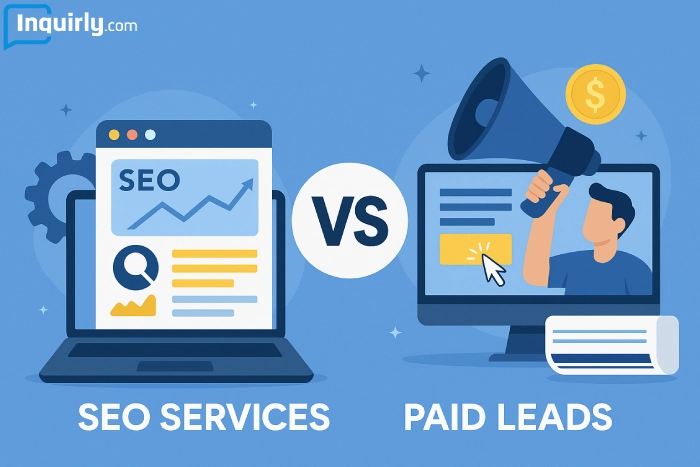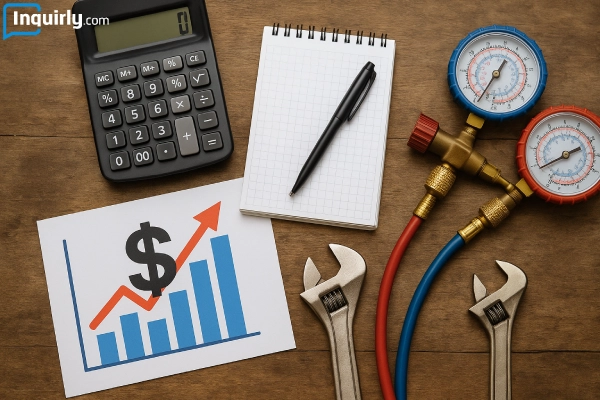In 2025, as digital advertising grows more competitive and complex, many HVAC business owners are left wondering: Do Facebook ads still deliver real value? With higher costs, algorithm changes, and increasing privacy restrictions, it’s easy to feel discouraged. But the truth is, Facebook ads still work – just not the way they used to. Success now depends on smart targeting, strong creative, and a results-driven approach tailored to today’s advertising environment.
the rules of HVAC marketing are being rewritten. What once worked, simple image ads with a “Book Now” button, may now burn through your budget without generating a single quality lead. The landscape has evolved beyond impressions and clicks to include strategy, precision and performance. Facebook, now deeply integrated into Meta’s advertising ecosystem, has shifted its focus toward machine learning, dynamic optimization and user-first engagement.
At the same time, consumer behavior has changed. Homeowners and property managers don’t just want service, they want trust, proof and convenience. Your ad not only needs to reach them, but it also has to resonate, convert, and follow up. If your HVAC business isn’t adapting, it’s falling behind.
That’s why understanding today’s Facebook ad dynamics is important. You need to know more than just how to set up an ad, you need to understand why certain campaigns succeed while others fail, how to optimize for performance instead of vanity metrics, and where the most common pitfalls lie.
This guide dives into the current effectiveness of HVAC Facebook ads in 2025. We’ll dissect the trends, explore ROI realities, highlight what’s working (and what’s not) and arm you with the knowledge to either improve your campaigns or shift your strategy entirely.
What’s Actually Working in HVAC Facebook Ads Right Now
Despite the rising noise and tightening algorithms, Facebook remains a top-tier platform for HVAC lead generation, when leveraged the right way. But surface-level tactics like “run a local ad” don’t work anymore. Success in 2025 hinges on how well you align your creative, targeting, funnel, tech stack and follow-up with the realities of modern consumer behavior and Meta’s backend logic.
Let’s break down the five most important things that actually move the needle in Facebook HVAC advertising today:
1. Geo-Targeted Service Video
Videos work, but not just any video. In 2025, the winning videos:
- Are vertical (9:16), fast-paced, and mobile-first.
- Use real footage, not stock – think service calls, installations, techs speaking on-site.
- Feature local cues: mention the city/neighborhood, show recognizable buildings or landmarks.
- Include on-screen captions, value propositions and clear CTA overlays
Meta’s AI rewards “watch time” and engagement, especially on Reels and mobile feeds. Local cues + real service content make viewers stop scrolling. You earn better reach, better click-through rates (CTR), and lower costs.
Pro Tip: Create a 3-Video Funnel Strategy
🎯 Video 1: Cold Awareness
Start by capturing attention from new audiences. Use this video to highlight the HVAC problem you solve, such as “Why Your AC Isn’t Cooling.” Keep it helpful and visually relatable.
💬 Video 2: Retargeting
Next, retarget viewers of Video 1 with testimonials, before/after footage, or service walkthroughs. Show satisfied customers and build trust with authentic feedback.
⏳ Video 3: Urgency & Action
Finally, deliver a time-sensitive offer. Promote next-day slots, weekend specials, or seasonal checkups. Add a clear CTA: “Book Now – Limited Appointments This Week!”
2. Facebook Lead Ads
Lead Ads are frictionless (users never leave Facebook), but the biggest mistake HVAC companies make is treating them like a passive inbox.
In 2025, lead quality isn’t the problem, follow-up speed is. According to Meta’s internal data and Salesforce, responding to a lead within 5 minutes makes them 21 times more likely to convert.
What works:
- Sync Lead Ads to a CRM (like HighLevel, HubSpot, or Zoho).
- Trigger an instant SMS/email drip AND a call notification to your team.
- Automatically tag and segment leads by zip code, service requested, and urgency.
Don’t use Lead Ads if:
- You’re not ready to respond soon.
- You lack a proper CRM or sales pipeline to track follow-ups.
Better alternative: Send leads to a dedicated landing page if you want more control and qualification upfront.
3. Offer-Based Ads
In 2025, consumers are overwhelmed with service ads, and generic messages like “Call us for HVAC help” no longer grab attention, they’re simply ignored. What actually makes people stop and take action are ads that include urgency, specificity and local relevance. For example:
A seasonal urgency ad might say:
“AC tune-up special only this week while temps hit 95°!”
A hyper-local scarcity message could be:
“Only 4 appointments left in Pasadena this Friday.”
Timely, event-triggered offer might read:
“Storm recovery HVAC checks now available – book your post-storm inspection today.”
These types of ads work because they create a sense of scarcity and relevance. When someone feels that an offer is limited, highly specific to their area and tied to a real need or current event, they’re far more likely to take immediate action.
To enhance performance even more, pair your ads with countdown timers or real-time availability features through tools like Calendly or GoHighLevel. These give users instant feedback and reduce hesitation.
One last tip: be sure to refresh your ads every 10 to 14 days during peak seasons. Facebook’s algorithm favors fresh, engaging content. Leaving the same creative running too long leads to ad fatigue, higher costs and fewer conversions.
Using Meta’s Conversions API + Pixel for Proper Tracking
Since Apple’s iOS update and expanding privacy laws, Facebook Pixel alone is no longer reliable for tracking.
In 2025, HVAC advertisers need to use:
- Meta Conversions API (CAPI) that connects server-side actions (form fills, calls, purchases) back to Facebook.
- Verified domains and custom event tracking to keep attribution clean.
- UTM-tagged URLs and CRM integrations to trace lead quality to ad source.
Without proper tracking, Facebook’s AI can’t optimize delivery. Your costs go up and your campaign performance stalls.
For the best practice: Set up both Pixel + CAPI, integrate with your CRM (e.g., via Zapier or native connector) and test events monthly.
What’s Not Working in HVAC Facebook Ads in 2025
(And Why You Should Stop Doing It)
Just as Facebook has evolved, so too has what fails to deliver. While certain fundamentals remain timeless (like clear offers and fast follow-up), many of the tactics HVAC companies relied on five years ago are now quietly draining ad budgets.
Let’s look at the most common missteps.
Generic Ads Without Context
Far too many HVAC businesses still run bland, copy-paste ads like:
“Need HVAC repair? Call us today!”
These types of ads are invisible. They lack a compelling reason to act, any sense of urgency, or targeting relevance. Facebook’s algorithm recognizes the lack of engagement and quickly suppresses these posts, raising your CPC (cost per click) while decreasing reach.
Why they fail:
- Low engagement signals to Meta’s AI = less delivery
- No incentive to click or convert
- Doesn’t speak to seasonal or local context
Boosted Posts Instead of Proper Ad Campaigns
Boosting a post seems easy, but it’s like buying billboard space without knowing who’s driving by. Boosts lack optimization flexibility, targeting control and funnel tracking.
Boosted posts often default to low-quality objectives like “engagement” rather than conversions. This leads to lots of likes or views but few actual leads.
Why this fails:
- Poor campaign objective (likes ≠ leads)
- No audience layering or testing
- Can’t retarget efficiently
Sending Ad Clicks to the Homepage
This is one of the most costly errors HVAC businesses still make in 2025.
If your ad takes a user to your homepage, where they have to dig through menus or scroll endlessly you’ve lost them. Modern Facebook users expect a clear next step that’s aligned with what your ad promised.
Why it fails:
- Poor alignment between ad and page (“message mismatch”)
- Lower conversion rates = higher cost-per-lead
- Facebook penalizes with lower relevance and higher CPC
Current HVAC Facebook Ad Costs in 2025
| Metric | 2025 Average |
|---|---|
| Cost Per Lead (CPL) | $45 – $120 (depending on market) |
| Cost Per Call-In Lead | $65 – $200+ |
| Appointment Booking Rate | 25% – 40% (with fast follow-up) |
| Cost Per Appointment | $80 – $200 |
| Cost Per Sale (Closed Job) | $150 – $450 |
| Recommended Ad Budget | $1,500 – $3,500/month |
| High-Intent Call Leads | $20 – $225 via partners like Inquirly |
*Caution: Always treat ranges as contextual.
These are averages, not guarantees. Variables include:
- Seasonality (summer = HVAC gold rush)
- Ad creative strength
- Zip code targeting
- CRM responsiveness
…
Biggest Trends in HVAC Facebook Ads in 2025
To compete today, HVAC advertisers must evolve beyond simple ads and understand where Meta’s advertising platform is headed.
Here are the top trends influencing performance-based campaigns in 2025:
AI-Curated Dynamic Creatives
Meta now offers tools like Dynamic Creative Ads, where you upload multiple images, headlines, descriptions and CTAs and Facebook automatically assembles the top-performing combinations in real time.
Instead of guessing what works, you let the algorithm test and optimize dozens of variations on the fly. It speeds up testing and increases your chance of hitting performance sweet spots early in your campaign.
Short-Form Video is Dominating
Facebook and Instagram Reels are now as essential as the News Feed.
Short-form video:
- Captures attention within 2 seconds
- Shows your brand in a mobile-friendly, full-screen format
- Encourages shares, comments and interaction
Combine Facebook Ads with Performance-Based Lead Gen
If building all of this in-house feels like too much, HVAC companies are increasingly turning to performance-first lead providers like Inquirly.
Platforms like Inquirly:
🔥 Deliver exclusive, pre-qualified HVAC leads
📊 Track ROI down to the call and form level
⏱️ Offer real-time appointment scheduling
📈 Let you scale spend based on actual results


